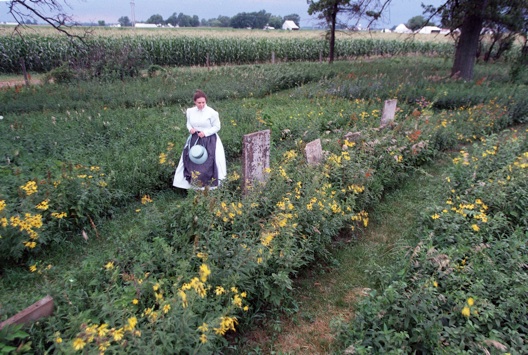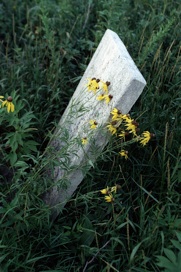Their names are but faint inscriptions on a sandstone slab in Bigelow Prairie Cemetery Nature Preserve.
Sisters Katherine and Serena Harrington died a day apart, probably in the same bed, the delirium of malaria erasing their consciousness. They were 12 and 14 when they were buried in the late summer of 1824. Numerous graves had been dug around theirs during the devastating "sickly years" in the newly settled Darby Plains.
Yet life goes on amid the relics of the dead.
Bigelow Cemetery rides like a seagoing skiff above the surrounding farm fields in northwest Madison County. Its towering stands of original prairie grass and brilliant flowers have never been plowed or grazed, leaving the half-acre plot almost a foot higher than the turf around it.
"History is deep here," said Diana Morse, a preserve volunteer who dons period costume to educate groups about pioneer life. "It's as deep as the prairie roots."
The tiny plot once was part of 1,000 square miles of virgin Ohio prairie. Today it is among the last remnants of a feral land that defied settlers to claim it. The cemetery became a state nature preserve in 1978 to protect a vanishing chapter of Ohio's botanical history.
The wind seems to whisper echoes of the people buried in the cemetery. A grasshopper flits off the headstone of a woman buried with her infant child. A bee collects nectar from a bright-red royal catchfly. The gentle hum of insects and the twittering of birds in bur oaks create a tiny universe that lulls the observer. One begins to muse about a time when pioneers tried to subdue the wild terrain and, in death, succumbed to it.
Cheap land
The Darby Plains were among the last areas settled by whites in Ohio, largely because the land was considered worthless.
"It supported no timber, was soggy for six months each year, very dry in the summer, prone to wildfires. These were extreme conditions," said Ron Demmy, Ohio Department of Natural Resources group manager for preserves.
But the Darby tracts were cheap. Revolutionary War veterans had received the land as payment and were eager to sell. A desperate group of Vermont natives was willing to buy. Earlier, the Vermonters had settled in Canada. At the onset of the War of 1812, they feared that the British would conscript them against their countrymen. They beat a hasty -- and, for some, penniless -- retreat to Ohio.
At less than $2 an acre, the price of the plains was right. But the cost of taming the land would prove tremendous.
A wagon train of 10 families fled Quebec in autumn 1812; Russel and Lucy Bigelow and their 11 children were among them. Fighting was scattered in Ohio; the threat of attack by Indians allied with the British loomed over the countryside. Almost no one settled the frontier that year, said Worthington historian Virginia McCormick.
"The war scare put a kibosh on development," she said. "It virtually stopped for about a year."
Nevertheless, the wagon train cut a swath across Ohio and headed to Worthington. The town, founded only eight years earlier, was the jumping-off point for settlers heading West.
"Worthington wasn't quaint; it wasn't Williamsburg," McCormick said. "We're talking horse manure, mud, scrap lumber, broken bricks. It was a mess. If an animal died, they left it behind the house to rot. That was one reason why there were so many diseases."
Rough start
Most of the wagon trainers rented or built cabins in Worthington to wait out the winter. Meanwhile, they made their first forays into the Darby Plains, where they would strike settlements along the Post Road running from Worthington to Urbana.
"The grasses were at least 5 feet tall when they first came, late in the autumn," Morse said. "Imagine the children, out in the prairie: They walk in, and they only go 25 feet in, and try to find their way back out again. They would get lost."
Wildflowers spattered the landscape with scarlet, gold, purple and orange. Coneflower, black-eyed susan, wild bergamot and tawny stands of Indian grass swayed in the breeze.
Newcomers such as Bigelow and his friend Nehemiah Sabin faced maddening obstacles. Timber for shelter had to be dragged from wooded areas. Rivers ran high. Three adult Sabin children lived isolated in a cabin that winter, stranded from the rest of the family on the opposite side of Little Darby Creek.
By spring, the frontier had claimed its first victims. In March, Russel Bigelow, whose family had stayed in Worthington, buried his mother-in-law and 8-year-old daughter, Abigail, in the town's St. John's Cemetery. Bigelow packed up the rest of his family and headed for the plains. (He would return that October to bury a second child, 17-year-old Dimmis.)
On the prairie, the real work began. The thick sod ruined the settlers' iron plows. Prairie grasses have tremendous root systems: As much as two-thirds of the plant lives underground. Turning even an acre of sod was a lengthy, back-breaking process.
"Old settler yarn tells of prairie vegetation so dense," Demmy said, "that a man riding his horse could rest his hat on grass tops while wiping his brow."
New ordeals
The isolation rattled the settlers. Some became despondent; the constant wind seemed to harass them. Fires -- some started by Indians to herd game -- devoured grasslands at a furious pace.
Certainly these were trials faced later by thousands out West. Darby settlers, unaware that their land stood at the eastern edge of a vast prairie ocean, were simply the first to experience them. They battled these elements 23 years before John Deere invented the steel plow, 40 years before Congress passed the Kansas-Nebraska Act allowing settlement of the Great Plains.
"It was very different from anything they'd been in," Morse said. "This was the wilds, the wilderness. They had a lot to challenge them."
Just as the first Darby pioneers began to break the prairie, the eldest of the Sabin sons fell ill.
"Nobody knew what it was," Demmy said. "I understand it was a painful death: severe vomiting, fever, shakes, jaundice. Finally the body just gives up."
The illness, likened to arsenic poisoning, swept through the Plains. The few available doctors described a bilious odor that permeated the cabins of the sick.
In September 1814, Hiram Sabin's body was laid into a grave cut from the thick sod, a patch of ground that would become Bigelow Cemetery. Within a year, his father, 11-year-old sister Phebe and several other settlers contracted the unidentified illness and died.
Only much later did the settlers understand. Fearing that their cattle would get lost in the big bluestem, farmers grazed them in small wooded areas. There the cows ate white snakeroot, which contains a toxin secreted in milk.
Almost no one who contracted milk sickness survived. The graves of children, who drank more milk than others, pervade Bigelow Cemetery.
Fire problems
In 1816, Russel Bigelow bought a tract that included the cemetery. Within three years, four of his children, his brother-in-law and a nephew were buried there.
More stubborn than the grasses, Bigelow and his neighbors sparred the elements, trying to break the soil and stop the fires.
"Fire is very much a part of the prairies," Demmy said. "It removes nonnative plants but keeps the prairie (root systems) intact. The ash even adds fertilizer to the soil."
Fire whipped across grasslands faster than a horse could run. Flames lashed 30 feet into the sky, decimating crops but not killing the tall grasses.
The settlers lighted backfires and cut firebreaks. They plowed under more and more native grasses until, eventually, the fires stopped.
The blazes, though, had thwarted an even greater enemy.
"When the large grasses didn't burn, they fell over into bogs," Demmy said. "Add to that lots of rain, and you have an excellent mosquito habitat."
In the summers of 1822 and 1823, entire families succumbed to malaria, an infection transmitted by mosquitoes. Throughout central Ohio, an estimated half the population contracted malaria in those years.
The pioneers called it "shaking ague" and believed it was caused by "bad air" from decomposing vegetation.
"There was scarcely a family but what had its sick and dying," Dr. Jeremiah Converse wrote of the epidemic in 1873. "All business transactions ceased, gloom brooded over the minds of the people and many a stout heart was made to tremble over the impending doom."
Malaria killed nearly one-quarter of the settlers in the Darby Plains. Quinine -- the only cure in the 1800s -- was unknown to them. The area was threatened with "depopulation," according to Beer's History of Madison County. "Emigration ceased, practically, until 1830."
In 1824, Russel Bigelow buried his wife, Lucy, next to four of their children in the tiny cemetery. No one remembers how she died.
Family legacy
Ruth Stewart, a wiry, white-haired lady in her late 70s, pushes her walker through the mowed paths of the cemetery. As a young girl, she and her sister were forbidden to go there.
"We'd climb the fence and go peek anyhow," she says.
Today, she surveys the headstone of her great-great-great-grandmother Lucy and considers the plight of a woman who lost much to gain little.
"The family, they never talked about it. It's one of those things to be expected," she said. "Death, it came natural, I guess."
Traveling to new places and breaking new lands was in the Bigelow blood, she says.
Beyond the preserve fence, another native American plant dances in the Darby wind. Corn fields extend in every direction, proof that early appraisals of the land were wrong. The Darby Plains became some of the richest farmland in Ohio. Making it that way just took several generations -- and a lot of sweat and tears. "Those poor souls; all that sickness," says Stewart, her voice trailing to a whisper.
Standing at the edge of the cemetery, she slaps at a mosquito. It falls, dead, into the prairie grass.
A PIONEER WHO’S WHO
When Russel Bigelow came to Ohio in 1813, he led a contingent of nearly 50 family members. The group, which emigrated from New England during the next five years, included five doctors, a circuit-riding minister and the founder of Plain City.
Ruth Stewart, Russel's great-great-great granddaughter who has researched the family, says many of those buried in Bigelow Cemetery are related by marriage.
"We're cousins to everyone, all the way to Irwin," she says.
Here are a few family members:
* Isaac, Russel's brother, came to Ohio between 1811 and 1813. He was the original owner of the land on which Plain City was founded.
* Brother Israel purchased the Plain City land from Isaac.
* Nephew Isaac, the son of Israel, walked to the area in 1814 to pay his uncle for the property. He founded Plain City in 1818. A doctor, he trained under his father.
* Sister Polly was in the second group of pioneers to settle the Darby Plains in 1813. Her husband, Samuel Tarpenning, and son Eliphas are both buried in Bigelow Cemetery.
* Sister Dimmis probably traveled with Polly in the second wagon train to Ohio. Her husband, Uriah Wood, and daughter Cynthia are buried in Bigelow.
This article was published July 22, 2001, in the Columbus Dispatch.
Story and photos copyright Columbus Dispatch.




